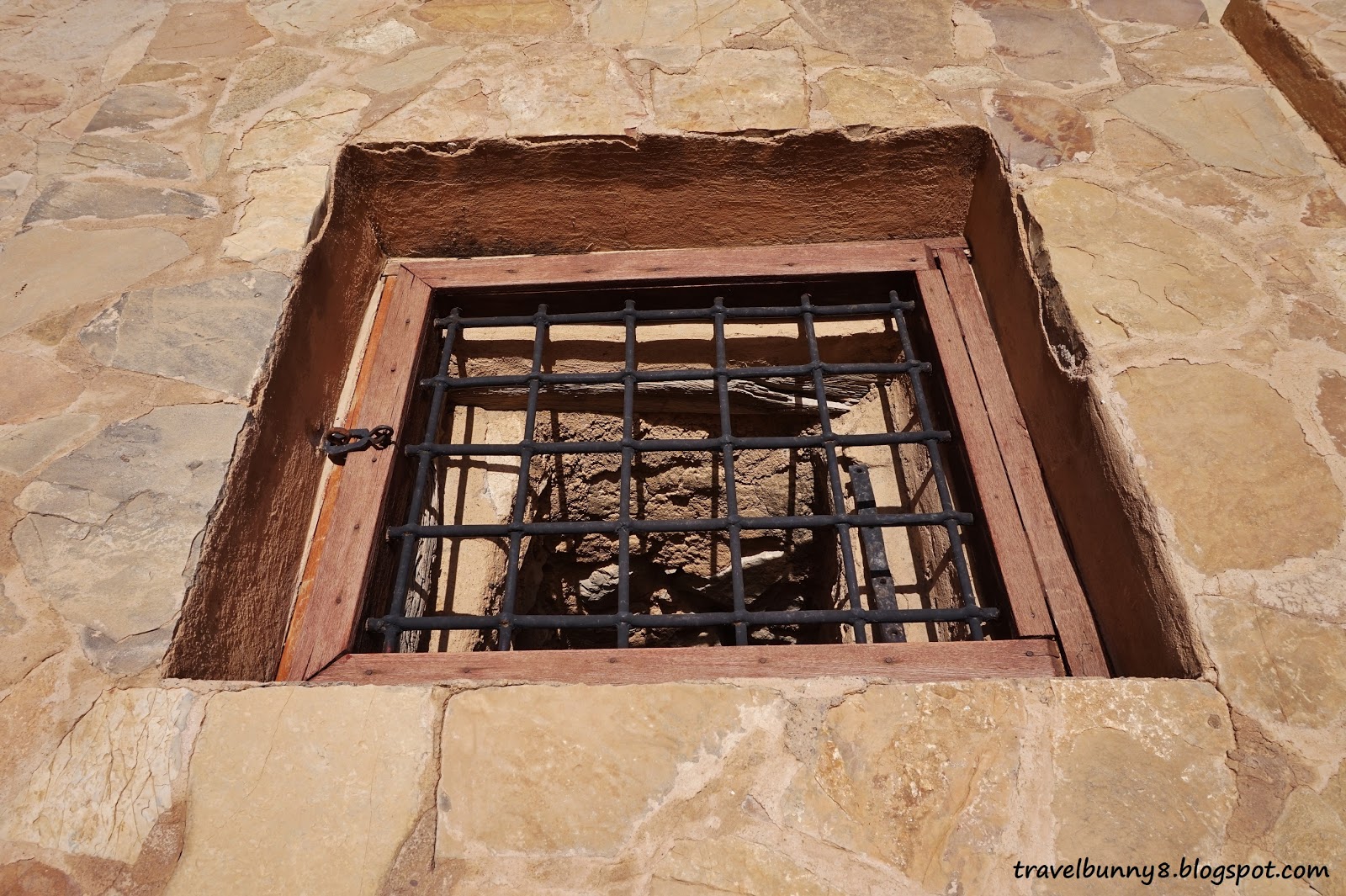[OMAN] Nizwa Fort and Nizwa Souq

Nizwa Fort is one the most visited tourist attractions in Oman and it is famed for its enormous round tower. The tower has a diameter of 45 meters, and to a height of 34 meters on massive foundations that extends a further 30 meters below ground. Its main tower also happens to be the biggest defensive tower in a fort in Oman.


The Friday Mosque stands at the side of the Nizwa Fort.

The outer portal of the fort is flanked by two historic cannons. One is a cast iron Swedish Finbaker, dating from the 18th century, mounted on a garrison carriage. The other is a fine example of a mid 16th century bronze Portugese cannon on a bed carriage.

Nizwa fort built in the 17th century by Imam Sultan bin Saif Al Yarubi, the first imam of the Yaruba dynasty. The fort structure took about 12 years to complete.The fort consists of enourmous, earth-filled, stone tower overlaid with traditional cement (saruj).

At the entrance of the fort, you can find a map of the fort. The structure consists of both a castle and a fort standing side by side. The towered citadel with its circular gunnery platform constitutes the 'Fort' and the adjacent residence of 'Castle' is also fortified.


The Fort is open from Sat to Thu 9 AM to 4 PM and Friday 8AM to 11AM. For Omanis, admission fee is 2 OMR for adult, 1 OMR for child (age 6-12) . For non Omanis, admission fee is 5 OMR for adult, 3 OMR for child (age 6-12) . Child under age 6 is free admission.


Courtyard of the fort.

This is a food station where local women make and sell snacks like traditional bread or pastry. The snack that I tried is Omani style crepe with honey as its filling.

Climbing the Nizwa Fort tower is a must-do thing when visiting Nizwa Fort. Access to the tower is by way of a dark, narrow, zig-zagging staircase, where at each turn a heavy wooden door defends against the threat of an assault. The doors are more than 10 cm thick and over a lintel of each is an opening for pouring boiling oil or water onto marauding enemies.

Remember to look up to see these murder holes.

There are around 6 pitfalls to catch enemies off guard in the dark passageway.

Some of the stairs were interrupted by deep, gaping holes over which planks were laid - to be quickly removed when the intruder alarm was raised. If the enemy survived assault from the murder hole that preceded each door, he would surely fall victim to the lethal pit on the other side.



The fort was built above a subterranean stream and wells are built inside the tower to ensure a permanent supply of water when subjected to a prolonged siege.


Took photo with one of the guards at the fort. He is wearing traditional Omani dress called Dishdasha with Omani turban.

This is a pit where prisoners are kept. The pit is deep and there is no way to climb out of it.


It is recommended to climb up the staircase to get an overview of the tower and its surroundings. Running all round the summit of the tower is a wall for use by 120 guards who kept watch over the surrounding countryside and were armed with muskets and flintlocks.

Four cannons remain on the tower's top, down from a total of 23, which once served as the fort’s main firepower. The canons can be fired in a 360-degree radius, making it virtually impossible for a surprise attack on the fort without provoking a reply from the cannons.

Old cannon balls are still kept on the tower.




By climbing to the top of the tower, you can view the surrounding lush oasis of date palms and the Hajar Mountains that loom over the town. The oasis is fed by Oman's unique water channel, Falaj Daris.

Next, I went to the castle of Nizwa. Nizwa Castle was originally constructed by Imam A'ssalt bin Malik Al Kharousi in the 9th century AH, near the old mosque. The castle was later renewed by Imam Nasser bin Murshid Al Yarubi in 1624 AD.

The castle contains both public and private rooms for the Imam, his family, his guests and other royal retainers. There were also kitchen, dates stores, wells, ablution rooms and prisons. The date stores, wells and baths have been kept in their original condition.




The former prison area of the castle with its maze of cells and rooms, has been transformed into an Exhibit Hall with a collection of more than 20 galleries. The rooms contains many exhibits to present the unique heritage and culture of the city of Nizwa and are also used to display artifacts.

There is also a nice gift shop near the exit.

The castle's perimeter wall featured a sentry walk for soldiers and loopholes for the firing of muskets.

Goodbye, Nizwa Fort.

Next, I went to the nearby Nizwa Souq.



Apart from the Muttrah Souq in Muscat, the Nizwa Souq is the other main Omani market.


This is the crafts market where you can buy various souvenirs.




There are other markets such as meat market, vegetable market, fish market, livestock market, fruits market and dates market in Nizwa Souq. But since I was visiting on the second day of Eid holidays, most of the shops were closed except for souvenir shops.

A trip to Nizwa is definitely one of the highlights of my trip to Oman. There is much to see and do in Nizwa.




![[MALAYSIA] How To Do A Self Guided Walking Tour in Kota Kinabalu](https://blogger.googleusercontent.com/img/b/R29vZ2xl/AVvXsEgR_cJjX4Shl9rsz0ufzxjmtLMq5PAvmTNDHypSVV2CYDaarZVj8EMznRkXqdVeCGg2yEMdFqPtI5rvrmMtJVSL1W9jqOtdCM2EFAc5ZTWn7XzPQV5sqS4s1DO0T_AuF0nq_dLQ53b9-ju3yyLJUrvU2TlhbmD4rDDV5-aPFaT2WEQZ1c257JXGUhyfsw/s72-c/20220524_131141.jpg)
![[FRANCE] My Favourite Paris Eiffel Tower Photo Spots](https://blogger.googleusercontent.com/img/b/R29vZ2xl/AVvXsEi220KHLfBDpyO53KorHwAb0KQEuiiaVDlrFYwEEAvs8YvKb-Edmyt7Hl7rZszN6qc-GM4e3SmjBS2pUiCiv8ljl8mnrUR93Ljxb0xGrSZ4sZLPRErpbAj29btKvnIC67xV93iKnrH3QRcc/s72-w781-c-h505/DSCF4372.JPG)
![[JAPAN] Osaka Universal Studio](https://blogger.googleusercontent.com/img/b/R29vZ2xl/AVvXsEilW88BKY24KkvC4WjRfTktmxFmylxMsDD8emYT93x8bOlgqzMV1feAp28Si_GPn3hyFD2E97CMmP3X6kceDfFa9WB_7qr2BFvmu20iVJRaNlZd1BfoyUUj5ZgofOgK5lZGoqVDS4-1YLTo/s72-c/?imgmax=800)


![[MONACO] How To Visit Monaco In One Day From Nice](https://blogger.googleusercontent.com/img/b/R29vZ2xl/AVvXsEgZkJeVAOmz4LTRwY2uDTK131UJVUWH_44GUUU3H-ni63dK2BlNqITBIh5Tdcpz9kXTUb7ePW7f-PQ1Y7E6B4lnqKEHs_nL3Eop-ouoFhxayMI4lNCcUG-oJnGMVwpGDlBu8lfgn10H_QHw/s72-c/DSC06605.JPG)

![[MOROCCO] My Day Trip to Blue City of Chefchaouen From Fez](https://blogger.googleusercontent.com/img/b/R29vZ2xl/AVvXsEh-7PIqgkIbF1BtTIOwfZ2R611OUrvV7f4Uxih57is62V_QD_DySCdifgR250MMruySrRmV7UMQ14iRsQZ6ifAaAWTqYacWSu__Lpm6QuqEjUcMZ4IJz-0SLDKeCV-nn6Zk1qbyMtMaZf4YupMArl4gXmmXoQUxHc6T-_eW-X2jvjh47rlu4Ddq4_Q48g/s72-c/DSC07946.JPG)
0 comments: